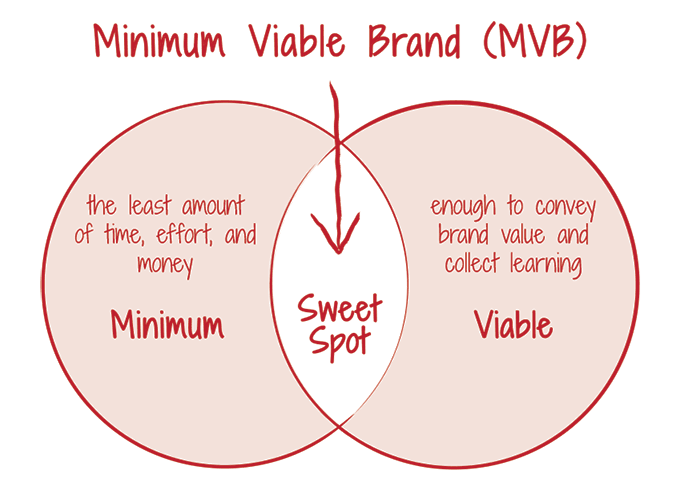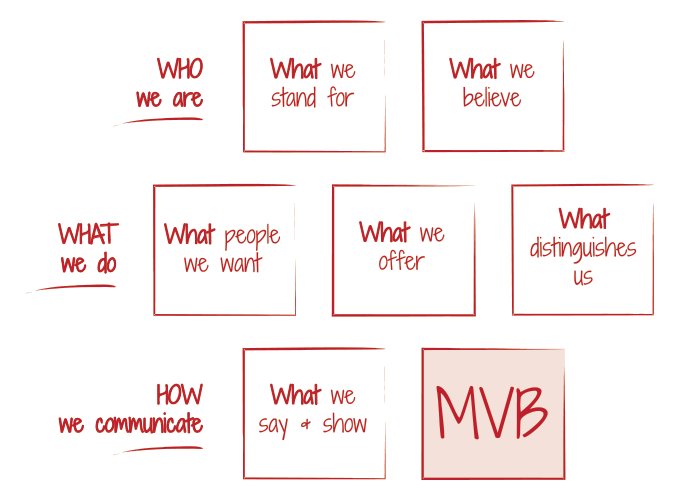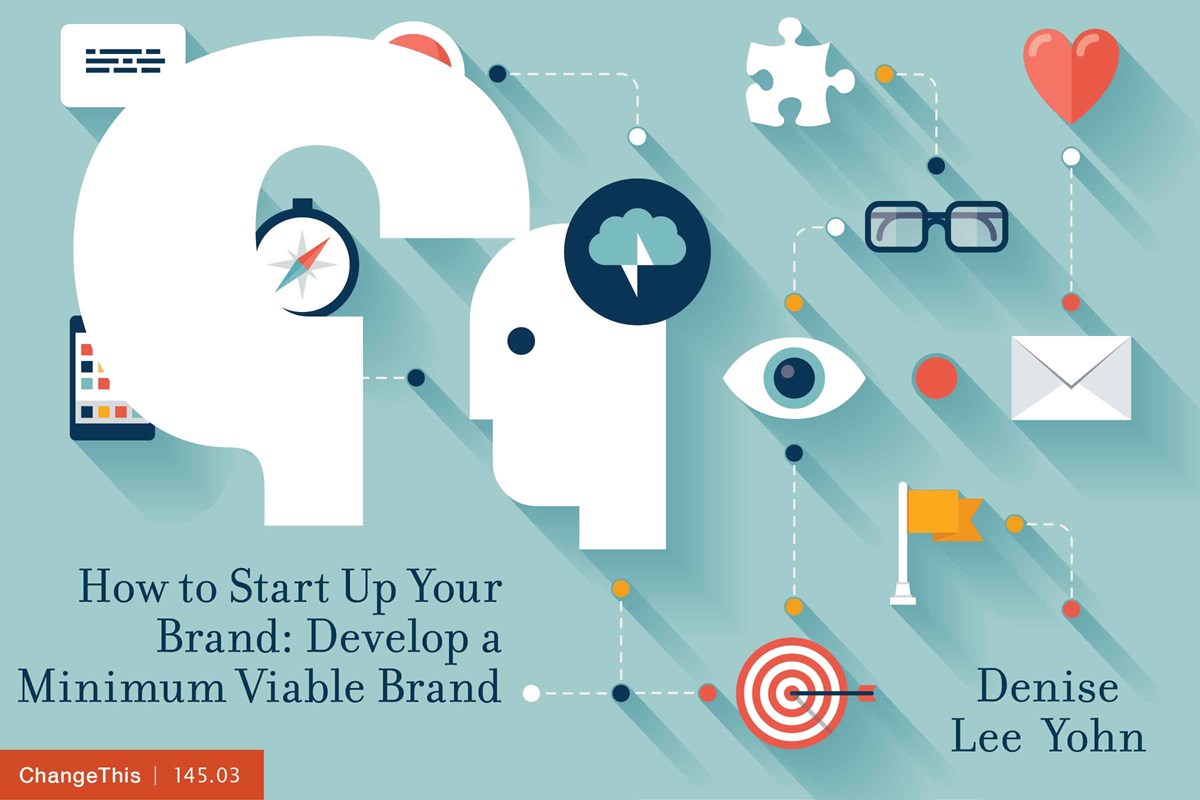How to Start Up Your Brand: Develop a Minimum Viable Brand
September 14, 2016
"With a MVB, you expend the least amount of time, effort, and money necessary to develop enough of a launch brand concept to center your organization, convey your value, and to collect learning. As an alternative to a complete strategic brand platform or simply a shell of a brand, a MVB provides you the perfect balance of structure and flexibility."
Congratulations! You’ve taken the plunge into entrepreneurship and are working on a start-up. You’ve made a bold, courageous choice, given the realities of today’s business environment.
The Global Entrepreneurship Monitor reports a staggering 100 million businesses launch every year. Just as astounding, the StartUp Genome Report shows that 92% of startups fail in their first three years. Management incompetence, insufficient capital, and overexpansion are among the most common diagnoses given for startup failurexbut these are mere symptoms of the fundamental problem.
Many startups get derailed because they don’t get their brand right. They rush into the marketplace thinking that a creative name, cool logo, and pithy tagline are all they need to launch their product idea. But the business isn’t grounded in a strategic foundation that provides the internal focus and clarity and external relevance and differentiation it needs to survive the myriad of challenges and threats facing new brands, much less to thrive as the business scales. Soon enough, the upstart finds it’s not attracting customers or investors, so it retrenches, plots a pivot, and tries (and fails) again—insanely doing the same thing over again expecting a different result.
To avoid this fate, you need to develop a Minimum Viable Brand (MVB). With a MVB, you expend the least amount of time, effort, and money necessary to develop enough of a launch brand concept to center your organization, convey your value, and to collect learning. As an alternative to a complete strategic brand platform or simply a shell of a brand, a MVB provides you the perfect balance of structure and flexibility.
“With a MVB, you expend the least amount of time, effort, and money necessary to develop enough of a launch brand concept to center your organization, convey your value, and to collect learning.”
Start-Ups Need Strong Brands
It may be difficult to appreciate the need for a robust brand if you think of one merely as a tool for attracting attention from external audiences. People have defined a brand as a company’s name, logo, image, advertising, aura, personality, look and feel, reputation, or trademark. But the fact is, none of these are your brand.
These are manifestations, symbols, or expressions of your brand—and by limiting the definition of your brand to this external, surface level, you fail to realize its full value to your business. When you examine how the world’s greatest brands were built, you will see the correct, complete view is that a brand is a bundle of values and attributes that define the value that you deliver to people through the entire customer experience, and the unique way of doing business that forms the basis of your company’s relationships with all of its stakeholders. Simply put, your brand is what your company does and how you do it. Your brand is not what you say you are—it’s what you do.
If you think of and build your brand in this way, it has so much power. It makes it easy for everyone who works on the brand to support it, to grow it, to decide what to do and not to do, because everyone knows so clearly what you stand for, what role you play in the world, and the way you’re meant to play it. It makes it ruthlessly clear how your resources should be spent so that you don’t waste them on things that aren’t right for you and your future.
Moreover, an integrated, aligned brand produces great value outside your organization. It allows you to charge more than your competition even if your products are essentially the same. Research shows people pay more for products and services from brands they esteem—and they do it willingly. So you can enjoy higher profit margins.
A strong brand inspires true customer loyalty. Your efforts attract those people who are likely to be your most valuable, loyal customers, and you’re able to develop with them relationships that are emotional, sustaining, and valuable.
You can enjoy lower overhead costs, not only in marketing, because you’ve got customers acting as your brand ambassadors, but also in employee costs because you have lower recruiting, training and development, and retention costs and lower turnover. And you’re in a stronger negotiating position with vendors and other business partners, because they want their brands associated with other powerful ones.
A strong brand also produces higher financial valuations and the good will to protect you when things go wrong.
Start-ups clearly need brands—brands that are more than superficial symbols and messages; brands that are integral and vital to their companies.
Spot-On for Start-Ups
Larger, more established organizations have the luxury of conducting extensive research, fleshing out nuanced dimensions and figuring out complex architectures, and eventually producing a thorough strategic platform for their brands. As a start-up, you probably are short on time, money, and attention, so a lengthy, laborious brand development process isn’t feasible. What’s more, your brand strategy should allow you the flexibility to try different directions and evolve as you learn from the market, especially given how quickly the landscape can change these days.
For several years now, tech upstarts have employed the Minimum Viable Product (MVP) concept, made popular by Eric Ries in The Lean Start-Up, to test product hypotheses with minimal resources. The defining principles of the MVP approach are speed, agility, experimentation, and iterative improvements. A MVB provides you with a similar tack to getting your brand right.

Just as a MVP allows you to launch in a compressed time frame and make necessary refinements to the product after the launch, a MVB provides an alternative to a complete, comprehensive brand platform. With a MVB, you expend only enough time, effort, and money to develop an initial brand concept that starts to guide your organization and engage your customers. You set in place the pieces of your brand that produce brand focus and clarity and then wait to develop the brand elements that provide more richness and dimension until after you’re in the market and have the resources as well as the customer and employee feedback and market insights to inform them.
“Your brand strategy should allow you the flexibility to try different directions and evolve as you learn from the market, especially given how quickly the landscape can change these days.”
A MVB grounds your launch in a brand foundation that is based in strategic intent and clarifying insights while not detracting from the agility and speed that today’s environment requires.
The MVB Framework
To develop a MVB, use a six-part framework. The framework contains six questions to answer— your 6 “Whats.” Two of the Whats define who you are as a brand, three of them explain what you do, and the last one describes how you communicate.
1 | What you stand for—your brand essence.
Your brand essence is the core idea of your business. Sometimes people phrase this is in the form of a purpose or your primary ideal. Others express it as your mission statement. Whatever form it takes, this should embody why you exist. It’s your reason for being—your “dent in the universe,” as Steve Jobs would say.
For example, Uber says it exists to make transportation as “reliable as running water, everywhere and for everyone.” In doing so, it “aspires to transform the way people connect with their communities, revolutionizing the way they move, work and live.” A visionary purpose like this provides clarity and inspiration to employees working on the business, drivers working in it, and customers benefitting from it.
2 | What you believe—your defining values.
Your values drive the way your organization operates. Just as family values helped your parents explain how they expected you to behave, your corporate values say to everyone, “This is the way we do things around here.” They should be clear, distinctive, and actionable. Slack, the business communication software company, has become valued at more than $3.8 billion within two years of its launch in part because of its unique modus operandi. CEO Stewart Butterfield explains his company operates by six core values, expressed in three sentences:
- Empathy as expressed through courtesy: Employees bring a lot of patience to their jobs and work hard to intuit what customers are trying to say because people aren’t always able to express what they want.
- Craftsmanship tempered with playfulness: Slack succeeds because of its employees’ mastery, but it doesn’t take itself too seriously. It’s known for deploying cheeky error messages like “We’ve seen this clear up with a restart of Slack, a solution we suggest to you now only with great regret and self loathing.”
- Thriving, both in ourselves and others: Employees work together in solidarity but also make sure they’re personally achieving their purpose.
3 | What people you want—your core customers.
Your technologies or offerings might be of interest to many different market segments and target customers, but you should specify the primary type or group of people you want as customers. With limited resources, you can’t appeal to everyone—nor should you want to try. The more focused you are on a specific customer target, the more valuable your brand will be perceived by it.
The most useful customer descriptions are not demographic (adults aged18-54), behavioral (discount shoppers), or economic (customers who spend $500+ in our category.) While these specifications may help you select media and channels to reach them, your MVB should use more distinguishing, meaningful characteristics. Ola Agbaimoni, founder of Eelan Media and Virgin Startup mentor, advises start-ups to speak directly to their customers’ “PAIN—problems, aspirations, issues, or needs.” This will help you identify competitive gaps and frame your brand in a way that presses the hot buttons of your ideal customers.
Some entrepreneurs hesitate to identify a specific target for their brand for fear of missing out on other opportunities. But doing so uses the MVB as it is intended—a means of learning whether or not you’ve made the right strategic choices.
4 | What you offer—your overall experience.
Some other brand frameworks may call for a value proposition, but that can limit your thinking and your flexibility. A value proposition is usually associated with a specific offering, so it can pigeonhole you into a specific product or service. Not only does this limit your options if you want or need to explore different versions or configurations, but it also sets up the value you offer to be primarily rational and corporeal.
Instead, consider the overarching experience that you offer. What is the feeling you inspire? What business are you really in? You may be selling clothes, but are you in the business of personal style, as online retailer Stich Fix is. You may be making coconut water, but are you in the all-natural vitality business, as Zico is.
“Your values drive the way your organization operates. Just as family values helped your parents explain how they expected you to behave, your corporate values say to everyone, ‘This is the way we do things around here.’”
5 | What distinguishes you—your key differentiators.
Differentiation is perhaps the most important factor in brand-building, so specifying what distinguishes your brand is perhaps the most important exercise in developing your MVB. Your key differentiators explain what you do that is different and better than the other options your core customers would consider.
Product attributes, technologies, ingredients, methods, claims, even your story are all possible differentiators. Use in your MVB the ones you believe to be most meaningful to your core customers even though others might be more difficult to achieve or more different from your competitors. Limit your selection to two to five differentiators and don’t define them too narrowly, otherwise you hamstring yourself into a very specific product design.
Take Hint water, for example. Founder Kara Goldin set out to develop a beverage that was all natural and low- or no-calorie. She also thought that a cold-fill manufacturing process was critical to achieve the taste standard she set for the brand, but she eventually discovered that hot-fill production would produce the shelf-stability she needed without compromising taste. By honing in on Hint’s key differentiators of health and taste, Goldin was able to develop a compelling brand and a viable business.
“Differentiation is perhaps the most important factor in brand-building, so specifying what distinguishes your brand is perhaps the most important exercise in developing your MVB.”
6 | What you say and show—your logo, lines, and look and feel.
Once you have set the first five elements of your MVB, you can turn your attention to how you express those elements in communications. At minimum, you will need a logo, lines (key messaging like a tagline), and a look and feel (a style for your visuals and copy.) Also consider developing your brand story, a short narrative that sets up your purpose.
These should be developed based on your answers to the other Whats, not your personal preferences which can be subjective and not necessarily a fit for your target or vision.
An example comes from Flyiin, a Berlin based start up in the travel industry. The team articulated its MVB to include the values of transparency, simplicity, and excitement. Its landing page, blog, and Twitter profile were designed to express those values in a communication style that is caring, clear, and intriguing.
These are the 6 Whats of your brand that you should carefully identify and clearly articulate before you launch anything. Without them, you subject your brand to the whims of the marketplace and could end up spinning your wheels without moving toward success and/or getting well off-track from your original vision. With a MVB, you set clear expectations for your brand—what you do and how you do it—among customers and employees, as well as strategic partners and investors.

You should be able to establish your MVB through a couple of focused, thoughtful working sessions among you and your partners. Sometimes it’s helpful to include an objective facilitator to encourage open and active participation and/or an inspirational muse to contribute out-of-the box ideas.
Progress Through Process
The MVP concept is based on validated learning—that is, learning by trying out an initial product idea and then measuring it to validate the effect. Instead of perfecting a product, launching it, and then determining if it succeeded or failed, start-ups put a MVP out into the market to test how various factors affect market acceptance. The viability of the product isn’t measured in aggregated measures like revenue so much as it is in the organization’s ability to address the insights it gleans.
In the same way, a MVB provides a path to learning. Having developed your MVB, you can start using it and see if your purpose provides enough decision-making clarity for your team, what kinds of employees you attract with your values, whether your core customer group is the right size to generate the level of demand you need, how your communication elements work in the different ways you and your customers want to use them, etc.
Through an iterative process of building, measuring, and learning, you can make changes to strengthen your brand and ensure it advances the business, supporting the model and addressing its risks and challenges.
If You Build It…
Starting a company is not unlike building a house. Once you have a vision for what you want to create, you basically have two options for your path forward. You could hire an architect and spend months pouring over designs, specifications, and materials to come up with the perfect rendition of the perfect house—only to turn the project over to a general contractor and find that your plans can’t be executed or the costs to do are astronomical.
Or you can take a different approach, design-build, which is becoming more common among house builders.
With design-build, designers and constructors work together with you as a team to plan and build your house. Desirability, feasibility, and budget are considered simultaneously so that fewer changes are needed. And when changes are called for, they can be implemented faster and more cost effectively.

Like design-build, using a MVB is an adaptable, responsive, and agile approach. Iterative design replaces extensive development, experimentation is favored over elaborate planning, actual feedback is used in lieu of intuition. It’s the path that more entrepreneurs are choosing these days.
The analogy between brand-building and house-building is also relevant because it reiterates the problem with most start-up branding efforts. Launching a brand with a mere logo and tagline is like starting to build a house by picking out paint colors and putting up a mailbox. Without the substance of a clear, focused, and integrated strategy behind those superficial signals, your brand remains simply a facade.
Starting a business may be one of the most creative and courageous acts people undertake these days. The rapid rate of change, rise of disruptive technologies, and elevated customer expectations threaten the prospect of success. A MVB can help you decrease the risks and increase your odds. Go forth!



